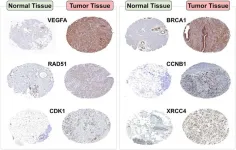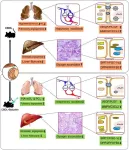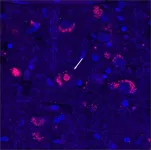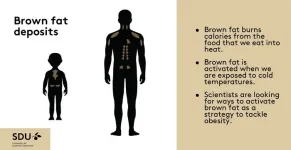(Press-News.org) Highlights:
The American Heart Association awarded four new scientific research grants to evaluate the role of race in measuring heart disease risk.
The funded studies are focused on multi-ethnic groups and studying how race, considered a social rather than biological construct, affects health risk prediction when it is incorporated as a variable in algorithms.
This research is funded by a grant from the Doris Duke Foundation to study the complex issue of how race and ethnicity, when factored into cardiovascular clinical care algorithms and risk prediction tools, affect equitable decision-making resulting from those algorithms.
DALLAS, April 29, 2024 — People with heart disease may receive different care because of how race is interpreted in health risk calculators and other tools that help clinicians make treatment decisions. The American Heart Association, a global force for healthier lives for all celebrating 100 years of lifesaving service, awarded four new grants this month to support scientific research that will evaluate the use of race in predicting heart disease risk and in turn help develop tools that are free of bias.
The newly funded principal investigators join six previous awardees who are part of a two-year scientific research strategy funded by a grant from the Doris Duke Foundation to study the complex issue of how race and ethnicity factor into clinical care algorithms and risk prediction tools. The grants are $50,000 each.
Clinical algorithms are formulas used to analyze health data and help determine a person’s risk for disease or guide their treatment decisions. Age, weight, information from blood or imaging tests, personal health history and health habits — like physical activity and smoking — are among the many types of data used by clinical algorithms. Some algorithms include race or ethnicity in their analysis to account for disproportionate disease rates among individuals of certain races or ethnicities. However, there has been growing scientific interest in reconsidering how race is used in risk calculators because race-corrected algorithms can negatively impact patient care and outcomes.
“These innovative research projects are focused on testing many different risk models that include a variety of health variables in an effort to remove racial bias from clinical algorithms. Our hope is that this research helps change the discourse about how race is considered in risk calculation,” said Jennifer Hall, Ph.D., FAHA, chief of data science for the American Heart Association.
The teams of scientists who received funding for the Debiasing Clinical Care Algorithms Data Grants are from Mayo Clinic in Phoenix, Arizona, University of Miami in Florida, University of Washington in Seattle and Boston University in Massachusetts.
The four research projects launched April 1, 2024, and will end March 31, 2025:
Fair opportunistic risk estimation model for ASCVD using routine non-contrast chest computed tomography exams – led by Amara Tariq, Ph.D., at Mayo Clinic in Phoenix, Arizona. This study aims to develop a machine learning model to estimate risk of atherosclerotic cardiovascular disease (ASCVD), including stroke and heart attack, using non-contrast computed tomography (CT) imaging of the chest. A deep learning-based pipeline will be developed to derive imaging biomarkers like coronary artery calcium, thoracic aortic calcium, intrathoracic fat and body composition metrics, from chest CT scans. These biomarkers are known to predict the risk of future ASCVD. This study is particularly focused on ensuring that the developed tool is fair and unbiased for all racial subgroups by incorporating adversarial debiasing techniques during model development. The developed model will be evaluated on diverse patient populations from large academic healthcare institutions.
Performance of race-based versus non race-based CVD risk calculators in a multi-racial/ethnic sample – led by Robert A. Mesa, M.P.H., a doctoral candidate in epidemiology at the University of Miami in Miami, Florida. This study will assess the American Heart Association’s Predicting Risk of CVD EVENTs (PREVENT) calculator in a multi-ethnic/multi-racial population. Researchers will use data from the Northern Manhattan Study, which is made up of more than 3,000 community-based participants. The group is 37% male and 63% female with 20% identified as non-Hispanic white, 25% non-Hispanic Black and 53% Hispanic background. The team will estimate ASCVD risk among these participants using both the race-specific pooled cohort equation (PCE) and the race-free PREVENT equation. They will then determine which equation better predicts 10-year risk of coronary heart disease or stroke.
Re-evaluating the role of race/ethnicity in the multi-ethnic study of atherosclerosis (MESA) and coronary heart disease risk – led by Quinn White, B.A., a Ph.D. student in biostatistics at the University of Washington in Seattle, Washington. This study will examine a race-free version of the Multi-Ethnic Study of Atherosclerosis (MESA) Risk Score. Researchers will update the model to remove race and ethnicity.
Assessing the role and importance of race and ethnicity in the clinical algorithm for predicting ASCVD – led by Yixin Zhang, M.S., a biostatistics Ph.D. candidate at Boston University in Massachusetts. This study has two objectives. One objective is to assess whether self-reported race and ethnicity affect atherosclerotic cardiovascular disease (ASCVD) risk prediction. The researchers will compare the Pooled Cohorts Equation, which considers race, with the new AHA Predicting Risk of Cardiovascular Disease Events (PREVENT) calculator that does not consider race. The second objective evaluates the extent to which a combined effect of social and environmental determinants explains the association between race/ethnicity and risk. They will assess whether social determinants of health and social deprivation index can replace race/ethnicity as representations of health disparities.
The American Heart Association has funded more than $5 billion in cardiovascular, cerebrovascular and brain health research since 1949. New knowledge resulting from this funding benefits millions of lives in every corner of the U.S. and around the world.
The Association receives funding primarily from individuals; foundations and corporations (including pharmaceutical, device manufacturers and other companies) also make donations and fund specific Association programs and events. The Association has strict policies to prevent these relationships from influencing the science content. Revenues from pharmaceutical and biotech companies, device manufacturers and health insurance providers and the Association’s overall financial information are available here.
Additional Resources:
New scientific research will test PREVENT risk calculator among diverse groups (Feb. 2024)
$150,000 awarded to research race in clinical algorithms (Aug. 2023)
Call to Action: Structural Racism as a Fundamental Driver of Health Disparities (Nov. 2020)
Follow AHA/ASA news on Twitter @HeartNews.
###
About the American Heart Association
The American Heart Association is a relentless force for a world of longer, healthier lives. We are dedicated to ensuring equitable health in all communities. Through collaboration with numerous organizations, and powered by millions of volunteers, we fund innovative research, advocate for the public’s health and share lifesaving resources. The Dallas-based organization has been a leading source of health information for a century. During 2024 - our Centennial year - we celebrate our rich 100-year history and accomplishments. As we forge ahead into our second century of bold discovery and impact our vision is to advance health and hope for everyone, everywhere. Connect with us on heart.org, Facebook, X or by calling 1-800-AHA-USA1.
END
New research funding awarded to assess the role of race in predicting heart disease
The American Heart Association funds four new projects to study how race in clinical algorithms affects equitable decision-making
2024-04-29
ELSE PRESS RELEASES FROM THIS DATE:
Exploring the role of seven key genes in breast cancer: insights from in silico and in vitro analyses
2024-04-29
Background and objectives
Breast cancer remains a significant global health concern, warranting further exploration into its genetic basis and potential therapeutic targets. This study aimed to elucidate the genetic associations of seven pivotal genes with breast cancer and discern their potential role in disease prognosis.
Methods
The genes VEGFA, BRCA1, RAD51, CCNB1, CHEK1, CDK1, and XRCC4 were curated from over 30 articles. Their association with breast cancer was analyzed using both in silico and in vitro techniques. The in silico assessment ...
The therapeutic effects of baicalein on the hepatopulmonary syndrome in the rat model of chronic common bile duct ligation
2024-04-29
Background and Aims
Hepatopulmonary syndrome (HPS) is characterized by arterial oxygenation defects due to pulmonary vascular dilation in liver disease. To date, liver transplantation remains the only effective treatment for HPS. This study aimed to explore the preventative role of baicalein in HPS development.
Methods
Sixty male rats were randomly assigned to three groups: sham, common bile duct ligation (CBDL), and baicalein, receiving intraperitoneal injections of baicalein (40 mg·kg−1·d−1, diluted in saline) for 21 days. Survival rate, liver and kidney function, and bile acid metabolism levels were evaluated. Liver and lung angiogenesis ...
Development and characterization of honey-containing nanoemulsion for topical delivery
2024-04-29
Background and objectives
Honey is a viscous, hygroscopic liquid in nature. It has the ability to treat wounds, wrinkles, aging, and inflammation. This study’s objective was to create and characterize a nanoemulsion containing honey and evaluate its stability.
Methods
A pseudo-ternary phase diagram was retraced with several concentrations of the Smix, water, and liquid paraffin oil to formulate nanoemulsions containing honey. From the results of pre-formulation stability studies, formulation HNE-19, with a hydrophilic lipophilic balance ...
Decoding cellular ‘shape-shifters’
2024-04-29
As embryos, all complex organisms are partially made up of pluripotent stem cells, a term for cells that have the capacity to differentiate into any kind of cell: nerve cells, muscle cells, blood cells, skin cells, and the like. As the ultimate biological “shape-shifters,” these cells are proving key to regenerative medicine, drug development, genetic research, and related fields.
Within a pluripotent stem cell, certain genes get activated and express information that ultimately decides a cell’s fate. The first step in this expression process is called transcription, a process that turns out to be incredibly complex, in part ...
"Seeing the invisible": new tech enables deep tissue imaging during surgery
2024-04-29
Hyperspectral imaging (HSI) is a state-of-the-art technique that captures and processes information across a given electromagnetic spectrum. Unlike traditional imaging techniques that capture light intensity at specific wavelengths, HSI collects a full spectrum at each pixel in an image. This rich spectral data enables the distinction between different materials and substances based on their unique spectral signatures. Near-infrared hyperspectral imaging (NIR-HSI) has attracted significant attention in the food and industrial fields ...
After 25 years, researchers uncover genetic cause of rare neurological disease
2024-04-29
**EMBARGOED BY NATURE GENETICS UNTIL 10AM BST/ 5AM ET/ 3AM MT, APRIL 29**
Some families call it a trial of faith. Others just call it a curse. The progressive neurological disease known as spinocerebellar ataxia 4 (SCA4) is a rare condition, but its effects on patients and their families can be severe. For most people, the first sign is difficulty walking and balancing, which gets worse as time progresses. The symptoms usually start in a person’s forties or fifties but can begin as early as the late teens. There is ...
Probing the effects of interplanetary space on asteroid Ryugu
2024-04-29
Samples reveal evidence of changes experienced by the surface of asteroid Ryugu, some probably due to micrometeoroid bombardment.
Analyzing samples retrieved from the asteroid Ryugu by the Japanese Space Agency’s Hayabusa2 spacecraft has revealed new insights into the magnetic and physical bombardment environment of interplanetary space. The results of the study, carried out by Professor Yuki Kimura at Hokkaido University and co-workers at 13 other institutions in Japan, are published in the journal Nature Communications.
The investigations used electron waves penetrating ...
T. rex not as smart as previously claimed, scientists find
2024-04-29
Dinosaurs were as smart as reptiles but not as intelligent as monkeys, as former research suggests.
An international team of palaeontologists, behavioural scientists and neurologists have re-examined brain size and structure in dinosaurs and concluded they behaved more like crocodiles and lizards.
In a study published last year, it was claimed that dinosaurs like T. rex had an exceptionally high number of neurons and were substantially more intelligent than assumed. It was claimed that these high neuron counts could directly inform on ...
Breakthrough in brown fat research: Researchers from Denmark and Germany have found brown fat’s “off-switch”
2024-04-29
Brown fat, also known as brown adipose tissue (BAT), is a type of fat in our bodies that's different from the white fat around our belly and thighs that we are more familiar with. Brown fat has a special job—it helps to burn calories from the foods that we eat into heat, which can be helpful, especially when we're exposed to cold temperatures like during winter swimming or cryotherapy. For a long time, scientists thought that only small animals like mice and newborns had brown fat. But new research shows that a certain number of adults maintain their brown fat throughout life. Because brown fat is so good at burning calories, scientists ...
Tech Extension Co. and Tech Extension Taiwan to build next-generation 3D integration manufacturing lines using Tokyo Tech's BBCube Technology
2024-04-29
Tech Extension Co., Ltd. (referred to hereinafter as TEX)[1] and Tech Extension Taiwan Co., Ltd. (referred to hereinafter as TEX-T)[2] have agreed with Innolux Corporation (referred to hereinafter as INNOLUX)[3] to build in a cleanroom of INNOLUX a manufacturing line intended for next-generation 3D integration[4] based on the Bumpless Build Cube (BBCube[5]), which is a technology achieved through the Tokyo Institute of Technology WOW Alliance[6].
TEX will transfer WOW technology[7] and COW technology[8], which are both based on the BBCube technology platform, to this manufacturing line intended for next-generation 3D integration. ...
LAST 30 PRESS RELEASES:
Neuroscientists devise formulas to measure multilingualism
New prostate cancer trial seeks to reduce toxicity without sacrificing efficacy
Geometry shapes life
A CRISPR screen reveals many previously unrecognized genes required for brain development and a new neurodevelopmental disorder
Hot flush treatment has anti-breast cancer activity, study finds
Securing AI systems against growing cybersecurity threats
Longest observation of an active solar region
Why nail-biting, procrastination and other self-sabotaging behaviors are rooted in survival instincts
Regional variations in mechanical properties of porcine leptomeninges
Artificial empathy in therapy and healthcare: advancements in interpersonal interaction technologies
Why some brains switch gears more efficiently than others
UVA’s Jundong Li wins ICDM’S 2025 Tao Li Award for data mining, machine learning
UVA’s low-power, high-performance computer power player Mircea Stan earns National Academy of Inventors fellowship
Not playing by the rules: USU researcher explores filamentous algae dynamics in rivers
Do our body clocks influence our risk of dementia?
Anthropologists offer new evidence of bipedalism in long-debated fossil discovery
Safer receipt paper from wood
Dosage-sensitive genes suggest no whole-genome duplications in ancestral angiosperm
First ancient human herpesvirus genomes document their deep history with humans
Why Some Bacteria Survive Antibiotics and How to Stop Them - New study reveals that bacteria can survive antibiotic treatment through two fundamentally different “shutdown modes”
UCLA study links scar healing to dangerous placenta condition
CHANGE-seq-BE finds off-target changes in the genome from base editors
The Journal of Nuclear Medicine Ahead-of-Print Tip Sheet: January 2, 2026
Delayed or absent first dose of measles, mumps, and rubella vaccination
Trends in US preterm birth rates by household income and race and ethnicity
Study identifies potential biomarker linked to progression and brain inflammation in multiple sclerosis
Many mothers in Norway do not show up for postnatal check-ups
Researchers want to find out why quick clay is so unstable
Superradiant spins show teamwork at the quantum scale
Cleveland Clinic Research links tumor bacteria to immunotherapy resistance in head and neck cancer
[Press-News.org] New research funding awarded to assess the role of race in predicting heart diseaseThe American Heart Association funds four new projects to study how race in clinical algorithms affects equitable decision-making






